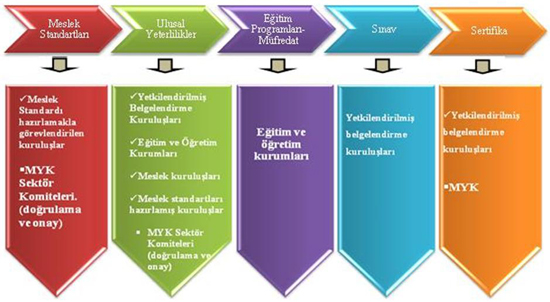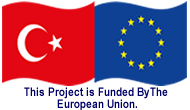- Error
BACKGROUND
Turkey has a population of approximately 71.6 million people. The country has a young population. Approximately 50% of the population are 29 years old or under. Approximately 18.1% are in the 15 – 24 age range. Unemployment rate in this group is determined as 24% in October 2009. The number of males in this age group is slightly higher than the number of females (2001 Census). Approximately 72% of employees are male by 2009. Employment participation rate of women is 27.1% across the country. Grant Schemes for promoting women' and youth employment are being implemented by the government with EU Funds to increase these rates.
Income distribution is skewed. The Ninth National Development Plan (2007 – 2013) states that the disposable income of the richest 20 per cent quantile was approximately 9.5 times more than that received by the poorest 20 % quantile in 2002. The income gap is, however, narrowing. It declined to the level of 8.1 in 2007. This year’s research results showed that 20.6% of the population lived below poverty threshold. In 2002 1.35 per cent of the population lived below the starvation line, but this had declined to 1.29 % in 2004. This rate determined as 0.74% in 2006 and 0.54% in 2007. However, poverty has increased in the rural areas in terms of some indicators. The Ninth National Development Plan (NNDP) notes, for example, that phenomenon of unpaid family workers is widespread in rural areas and constituted the poorest group in 2004. Furthermore, those who migrate to urban areas as a result of the structural change in agriculture often experience social adaptation problems due to low levels of education and lack of skills. These people are generally employed on daily wages in the services sector. The poverty rate amongst this category of workers was estimated to be 37.5 % in 2004.
Employment in the agricultural sector has decreased at an annual average rate of 3.3 % in the 2001-2005 period, but in the non-agricultural sectors employment has increased by 2.5 %. Nevertheless, because of the global economic depression, employment in agricultural sector increased to 26.1%.
The main economic sectors in Turkey are automotive and related sub-sectors, tourism, construction, transportation, energy, metal industry, plastic and chemical industry, textile and leather products.
Structural problems restrict rapid development of the manufacturing industries. These problems include inadequacy in production technology, inability of rapid spreading modern technology usage, lack of qualified labour force, limited production capability in high value-added products, inability to undertake sufficient investments in emerging sectors, need for improvement in production and management facilities, difficulties in investors’ access to information, inability to establish organized industrial zones, and unfair competition resulting from the informal economy and from imports (NNDP: pp 43, para 197).
The rate of employment in Turkey is low. The percentage of those “employed within the entire working age population continues to remain low and was realized as 43.4% as of 2005” (NNDP, pp 24). The number of employed persons in the working age category was estimated at 22.1 million in 2005. High unemployment amongst the young and the educated population is a major problem in the labour market. A high percentage of those participating in the labour market have a low education level. According to the NNDP, 73.8% of the labour force in 2000, 67.3% in 2005 and 59.2% in 2009 had a level of education that is below upper secondary education. Employment participation rate among this group is 46.6%. Those with higher education training accounted for only 8.8% of the labour market in 2000, and 11.5% in 2005. This groups’ employment participation rate is 78%.
According to Turkish Statistical Institute data, unemployment rate across Turkey was determined as 10.3% in 2005 and 9.9 % in 2006 but, due to negative influences of global depression, these rates increased by 6 points and reached to 16.1%. By October 2009 with governmental projects that intend to promote employment, especially “active employment policies” that were developed by Turkish Employment Organization, this ratio decreased to 13%.
The unemployment rate of vocational graduates is high, despite the fact that industry experiences difficulties in finding suitably qualified middle level workers. In 2000 the unemployment rate amongst vocational graduates was 10.9%, increasing to 13.3% in 2005. The reason of this situation is considered to be the fact that the the students with high cognitive skills are not highly interested in vocational education. The vocational education system not being able to meet the requirements of the labour market, due to lack of stakeholder participation in the updating of vocational education programmes, lack of equipment and insufficiently qualified staff in the training centres (ibid: pp48, para 231).
Taking the above mentioned challenges into consideration, Vocational Qualifications System will help harmonization of demand-supply of the labor force market. Vocational Qualifications Authority (VQA) has been established with the Law numbered 5544, dated 21September 2006 with the task of determining the national qualifications based on the occupational standards in technical and vocational fields, and implementing activities related to audit, measurement and assessment, and certification. VQA which is the affiliated organisation of the Ministry of Labour and Social Security (MoLSS) is a public entity with administrative and financial autonomy, and has a private budget. The main duty of the Authority is to establish and operate the “national vocational qualifications system” in line with European Union.
By virtue of the consistency in training and certification (there is no qualification base and standard for these training programmes; different programmes, different environmental conditions, different methods and techniques are used for the same certificates and documents in the same fields) and a national VET testing system (there is neither an examination nor a certification centre at the national level in Turkey that can accredit institutions determining occupational standards and the related education standards) are absent and also individuals who acquire the same vocational skills by formal and non-formal education cannot be provided with occupational certificates of equivalent value, student enrolments to vocational and technical education institutions are made without a plan, which takes account of the human resources demands of the labour market, and monitoring and evaluation-assessment mechanisms cannot be used effectively for the evaluation and review of programmes, there is a great need for the occupational standards development, skills testing and certification centres based on National Qualifications System (NQS).
The following flow chart shows the stages and actors and how the National Vocational Qualifications System is supposed to function starting from the occupational standards and qualifications to training, testing and certification procedures in the system..

In this context, EU project called “Strengthening Vocational Qualifications Authority (VQA) and National Qualifications System (NQS) in Turkey” aiming to support the VQA and Occupational Standards Development, Vocational Knowledge and Skills Testing and Certification Centres (VOC-TEST Centres), to establish and initiate an efficient and sustainable National Qualifications System based on agreed occupational standards with an appropriate system for assessment, grading and certification at all levels in line with European Qualifications Framework has been commenced.
The Project is designed to assist the VQA design, pilot, and formalize a NQS, and to build capacity in the VQA, its social partners, and other stakeholders to ensure the continued development, expansion and sustainability of the system. The Project will assist the VQA operationalise and assess the feasibility of the design. This will include developing and piloting procedures for the preparation of occupational standards and for testing and certification, and the establishment of VOC-TEST Centres, and related quality assurance mechanisms. The Project will focus on Levels 2 -6.
The main objective of VQA is to improve and disseminate its activities including all sectors. Furthermore, improving employment possibilities by recognition and certification of prior learning, providing quality assurance and mutual recognition of vocational qualification certificates, minimizing the difficulties caused by incompatibility between formal education and working life are among the primary objectives of VQA.
VQA has organs consisting of the General Assembly, the Executive Board, the Sector Committees and the Presidency. Since 2007, when VQA has commenced its technical activities, the secondary legislation, its principles and procedures have been determined; the personal, physical and financial sources have been provided; the first occupational standards and national qualifications have entered into force; the accredited testing and certification institutions have been authorized; the internationally comparable Vocational Qualifications Certificates have been provided; VQA has become the National Europass Center (NEC) of Turkey as of 2008; and VQA has become National Coordination Point for European Qualifications Framework (EQF) in Turkey and also a member of Advisory Group for EQF as of 2008.
This Guideline for applicants describes the objectives, priorities and eligibility rules of the VOC-Test Centres Grant Scheme.
The institutional framework of the Grant Scheme includes the Vocational Qualifications Authority (VQA) and the Central Finance and Contracts Unit (CFCU) of the Republic of Turkey. VQA as the Beneficiary of the Project will be responsible for the technical implementation of the project according to the rules of the Operational Agreement signed with the CFCU and also will co-ordinate the monitoring of the grants awarded under the overall supervision of the Programme Authorizing Officer (PAO). The CFCU is the Contracting Authority for the project, and is responsible for the administrative and financial implementation of the Grant Schemes. The CFCU has ultimate responsibility for the correct use of grant funds and is responsible for the tendering, contracting and payments and is referred to in this document as the Contracting Authority.
This grant is financed by EU under the IPA-1 component of 2007 programming of Turkey-EU Financial Assistance.
OBJECTIVES OF THE PROGRAMME AND PRIORITY ISSUES
The global objective of this Call for Proposals is ensuring the provision of formal, non-formal vocational, technical education and training according to labour market needs, supporting life-long learning, strengthening the relation between education and employment, and facilitate harmonization with European Qualifications Framework (EQF).
The specific objective of this Call for Proposals is:
To establish and/or develop and operationalize Occupational Standards Development Vocational Knowledge and Skills Testing and Certification Centres (VOC-TEST) in 11 priority sectors which are automotive and related sub-sectors, tourism, construction, transportation, energy, metal industry, plastic and chemical industry, information and communication technologies, printing and publishing, machine design and manufacturing, and textile, ready wear and leather products sectors in order to establish and initiate an efficient and sustainable National Qualifications System (NQS) enabling appropriate assessment, grading and certification system at all levels in line with European Qualifications Framework.








